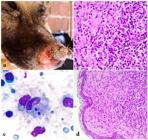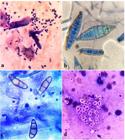ABSTRACT
Faced with the lack of studies on the frequency of dermatopathies that affect dogs by geographical region in Brazil, the present study aimed to evaluate the frequency of dermatopathies that affect the canine species in the metropolitan region of João Pessoa, Paraíba, Brazil. Data was collected from dogs that underwent dermatological care from September 2014 to December 2016. In addition to the clinical and dermatological examinations, dogs underwent complementary exams, such as cytological, skin scraping, parasitological skin examination, trichogram, bacteriological, mycological, histopathological and/or polymerase chain reaction. During the study period, 1,083 dogs were examined, in which 18.65% (202 /1,083) had some form of non-tumoral dermatopathy. Of the 202 dogs affected, 51.49% (104/202) were males and 48.51% (98/202) females. Of these 202 dogs, thirteen had two diagnoses, totaling 215 dermatopathies. 62.87% (127/202) of the affected dogs were purebred and 37.13% (75/202) were without a defined breed (WDB). The most frequently observed lesions were alopecia, hypotric, macular, erosive and ulcerative, placoid, erythematous areas, as well as comedones, collaretes and seborrhoea. The parasitic dermatopathies were the most frequent (35.35%; 76/215), followed by bacterial dermatopathies (24,19%; 52/215), allergic dermatopathies (20,00%; 43/215), dermatomycosis (17,21%; 37/215), dermatopathies for other causes (2,32%; 5/215) and autoimmune dermatopathies (0.93%; 2/215). Clinical and dermatological examination, including a detailed anamnesis, accurate clinical history and associated complementary exams are important tools for the diagnosis of dermatopathies in dogs. Available literature present some studies with canine dermatopathies frequencies superior to that obtained in the present study; however, the number of animals examined was smaller. In this survey, it was possible to establish the primary and secondary diagnoses in 100.0% of the non-tumoral dermatopathies in dogs, results higher than in previous studies. Probably, the frequency of canine dermatopathies in this region is higher than that observed, thus requiring additional studies with greater sampling.
Keywords:
dogs; dermatology; complementary exams; non-tumoral diseases

 Thumbnail
Thumbnail
 Thumbnail
Thumbnail
 Thumbnail
Thumbnail
 Thumbnail
Thumbnail



